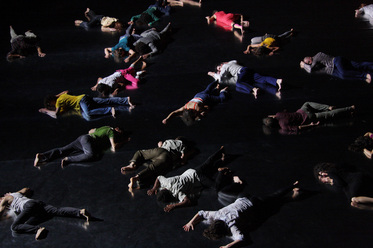 Levée des conflits, photo by Caroline Ablain Levée des conflits, photo by Caroline Ablain One dancer climbs onstage, wipes the floor with her hand until she is down on her elbows, shaking her ass, at which point another dancer walks up the stage and begins to wipe the floor. There will be twenty-four of them, performing the same series of twenty-five movements, over and over again. This initial canon allows the audience to travel back in time all depending on which dancer their eyes rest on at any given moment. This is Boris Charmatz’s Levée des conflits. It is in one way chaotic because of the sheer number of performers; and yet it isn’t because each is so clearly doing exactly what they should be doing. And the first dancer begins to wipe the floor again, a loop is formed, and we understand: we are locked into this sequence. There is something of Canadian experimental filmmaker Michael Snow in Levée de conflits. Like in his movie Sshtoorrty, in which the same simple short story is not only overlapped but repeated at least ten times. And yet each time the viewer notices something different since human perception is such that not everything can ever be all taken in at once; which is why when people say that, after a certain point, they “got it,” you know they didn’t get it because it’s simply impossible. We can also think of his seminal film Wavelength, a 45-minute zoom across a mostly empty loft. In terms of storytelling, Wavelength is cheekily minimalist, but the celluloid is manipulated to such a degree that on a formal level it is so excessive as (again) to make viewers feel like they have always missed something. With its changes in lighting, no matter how seemingly few, the same could be said of Levée des conflits. And the variations occur. They perform the sequence while going in a circle in a space that progressively gets smaller. Time seems similarly condensed. Then they slow the movements down as they get even closer to each other. One could also be reminded of Michael Trent’s conceptual show It’s about time: 60 dances in 60 minutes, in which dancers repeated the same sequence of fifteen actions four times, each action first taking a minute, then fifteen seconds, then three minutes, then a minute again. Levée des conflits might be less playful than It’s about time, but more ambitious in scope. Then some of the dancers can be seen performing the sequence backwards, until they are all wiping the floor. And the cycle begins anew, abandoning the canon in favor of synchronicity. The choreography’s simplicity gets exposed, and yet it’s also more pleasurable. What is it about synchronicity? Is it because deep down we’re all order-loving fascists? Is it because it gives us something the universe doesn’t? The illusion of control, no matter how trivial? We exit Levée des conflits the same way we entered it, like the characters in Luis Buñuel’s The Exterminating Angel. It will have taken an hour and forty minutes to complete the cycle, but it will be with a feeling of resolution so logical that it might induce chills. I usually try to avoid saying such platitudes, but hopefully the advantage is that when I do say them you know I mean it: Levée des conflits is the best dance show that’s been presented in Montreal this past year. May 30 & 31 at 8pm Place des Arts – Théâtre Jean-Duceppe www.fta.qc.ca 514.844.3822 / 1.866.984.3822 Tickets: 48-58$ / 30 years old and under: 43-48$
0 Comments
Leave a Reply. |
Sylvain Verstricht
has an MA in Film Studies and works in contemporary dance. His fiction has appeared in Headlight Anthology, Cactus Heart, and Birkensnake. s.verstricht [at] gmail [dot] com Categories
All
|
 RSS Feed
RSS Feed